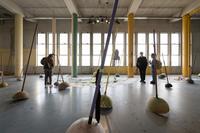Chapter 5IVE
Relearning Aquatic Evolution (2022)
Relearning Aquatic Evolution, 2022
Mixed media
From time immemorial, the Netherlands has sheltered behind ever-higher dykes. We have been schooled to think of these dykes as our raison d’être, that they save us from destruction. But is that true? Is the continual raising of dykes due to the rising sea level a sustainable solution, and what would happen if we would welcome the sea instead? To what extent are humans able to adapt physically and develop a more symbiotic relationship with water?
Since 2015, the artist collective de Onkruidenier has been conducting research on how we can build a different relationship with our saline and increasingly wet living environment. Their proposition is that humans can adapt not only technologically but also physically and biologically to their surroundings. For instance, studies show that sea nomads, like the Bajau people near Indonesia, developed a different physiology, resulting in their eyes responding better to saltwater and being able to hold their breaths for minutes on end. In the Netherlands too people lived symbiotically with water for centuries. In the north of Friesland and Groningen they build their houses on artificial mounds, the land around it flooded regularly.
In Het HEM, de Onkruidenier presents an aquatic revolution: in this training area, visitors can train their bodies with the help of tools to become sea-loving creatures. From elastic bands and headgear to help increase the elasticity of our imagination, to activating our vocal skills and training our ‘tongue waves’, which simplify communication in an aquatic environment and moreover increase our lung capacity. With the help of these training objects, the urge to be on dry land gradually decreases, and a future is imagined where we’ll bob along to the rhythm of the waves.
